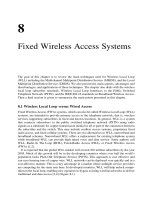Wireless & Mobile Systems
Bạn đang xem bản rút gọn của tài liệu. Xem và tải ngay bản đầy đủ của tài liệu tại đây (256.89 KB, 11 trang )
Wireless & Mobile Systems
Goals and Content of this Course :
Part I – Overview & Concepts (4t) (Mardi 16/09/08)
•
To give a clear and basic view on the Wireless and Mobile Communications.
1.1 Summary on Communication Networks (Cf.Pujolle 2008, french version)
1.2 History (To be defined : Cf.Papadimitriou – 2005)
1.3 Cf Cours2008_Berlin (Schiller)
Part II – Fundamentals (8t) (Mardi 23/09 - Jeudi 25/09/08)
2 Fundamental aspects on Wireless and Mobile Communications (Cf.See books of Papadimitriou, Molisch, Schiller,…)
Part III – Basic cases on Wireless and Mobile Systems (12t) (Mar 30/09 - Jeudi 02/10 – Mardi 07/10)
3 More details on one case : the GSM (2G) system
4 Basic GSM – GPRS Systems
4.1 GPRS system
5 3G (CDMA,OFDM)
Part IV – Wireless networks (8 tiet) – IEEE802.11 (Jeudi 09/10 – Mardi 14/10)
Part V – Pratical Deployments and Implementations (To be prepared by Bui v minh) (8 tiet) (Jeudi 16/10 – Mardi 21/10)
5 Some pratical aspects on Design and Implementation of GSM-GPRS System
5.1 OMC-R case (Software and Hardware Design,Tests and Deployment )
5.2 UMA case (Software and Hardware Design,Tests and Deployment)
Part VI – The Future (4t) (Jeudi 23/10)
6 Advanced systems and Evolution (4G,LTE,SAE, HSPA Evoled,…with OFDM, MIMO)
Introduction
What Is a Wireless System?
In the most general sense, a wireless system is any collection of elements (or subsystems) that
operate interdependently and use unguided electromagnetic-wave propagation to perform some
specified function(s). Some examples of systems that fit this definition are :
•
Systems that convey information between two or more locations, such as personal communication
systems (PCS), police and fire department radio systems, commercial broadcast systems, satellite
broadcast systems, telemetry and remote monitoring systems
•
Systems that sense the environment and/or objects in the environment, including radar systems
that may be used for detecting the presence of objects in some region or volume of the environment
and measuring their relative motion and/or position, systems for sensing or measuring atmospheric
conditions, and systems for mapping the surface of the Earth or planets
•
Systems that aid in navigation or determine the location of an object on the Earth or in space
Each of these systems contains at least one transmitting antenna and at least one receiving
antenna
In contrast to a single-link wired system , the signal environment of a wireless system is hostile :
•
The direction of the signal cannot be completely controlled, and the path between endpoints is not
unique.
•
The path between endpoints is time-varying.
•
Signal dropouts are frequent.
•
Noise and interference levels are often difficult to predict and time-varying.
•
Objects in the path between and surrounding the endpoints affect the signal level and its content.
•
Variations in the signal environment change with geographic location, seasons, and weather.
•
For mobile systems, as in cellular and PCS systems, at least one of the endpoints may be moving
at an unknown and sometimes significant speed.
- Black
Introduction 2
Introduction 3
General Architecture, Basic Concepts, and Terminology
General block diagram of a wireless system for a generic application as shown in Figure 1.1. Many
of the blocks and their functions apply to both wired and wireless communication systems. Note,
however, that the blocks contained within the dashed outline are fundamental and necessary to
wireless systems. With the exception of the antennas, all of the remaining blocks may also be found
in wired system applications.
Figure 1.1. A Wireless System
Introduction 4
Cấu trúc tổng quát, Khái niệm cơ bản, và Từ ngữ
Sơ đồ tổng quát các khối của hệ thống không giây được biểu hiện trên Hình 1.1. Đa số các khối và
chức năngđều đươc dùng cho cả hệ có và không giây. Tuy nhiên các khối nằm trong vạch rời là cơ
bản và cần thiết cho hệ thống không giây. Trừ các antenna, các khối còn lại đều được dùng cho
các hệ có giây.
Hình 1.1. Một hệ thống không giây









